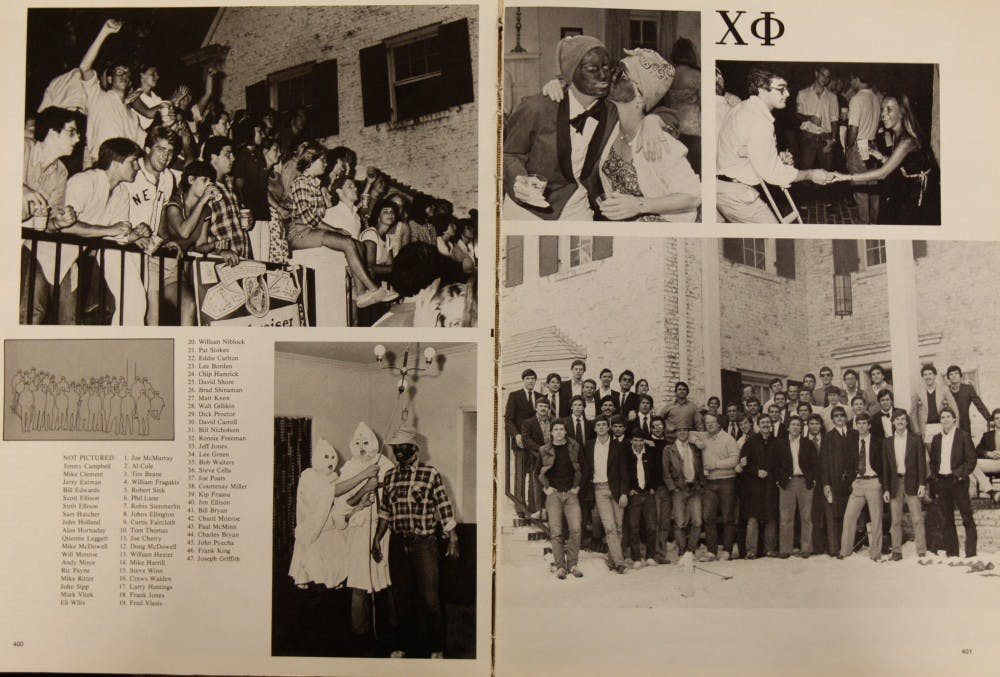“It’s a way of just appropriating a few qualities of African Americans that whites want to appropriate, either because they think it’s funny or because they think it’s a way to create a degrading image of African Americans,” he said.
Brundage said blackface was sometimes used as a way to adopt a role or play out a fantasy, often being done to portray Black men as “inarticulate” and “dumb” or “to mimic African American men who are allegedly really gifted at music and dance.”
The latter could be true of Northam, who admitted to dressing in blackface to portray Michael Jackson — though on a separate occasion from the infamous photo — but Brundage assured that blackface is inappropriate in all contexts. As for the Yackety Yack photo, he described it as “outright mockery.”
“Lynching is not a funny, comical thing. It’s an extralegal execution," Brundage said. "And the Ku Klux Klan was not a funny organization. It was a terrorist organization.”
The photo caused a stir for UNC, and on Feb. 7, both interim Chancellor Kevin Guskiewicz and interim UNC-system President Bill Roper condemned the photo as “a horrific part of our past” and as something that is not representative of the University, neither now nor in 1979.
Chi Phi National released a statement on Twitter on Feb. 6 in response to the photo, as well.
“We strongly denounce the behavior and sentiments displayed in these images,” the statement said. “Bigotry is not welcome in our fraternity.”
At the time of publication, the UNC chapter of Chi Phi had neither responded for comment nor released a statement.
The current staff of the Yackety Yack also found itself in a difficult situation when the photo came to light, but the yearbook’s editor-in-chief, junior Alexandra Smith, was not very shocked to hear about the photo’s existence.
“It was kind of like a feeling of disappointment, but not surprise, in the decisions made by past Yackety Yack editors,” Smith said. “I wasn’t expecting it to blow up as big as it did, but my first thought was, ‘Oh my gosh, how are we going to recover from this,’ because that’s not reflective at all of who our current staff is.”
To get the day's news and headlines in your inbox each morning, sign up for our email newsletters.
As Smith noted, the executive staff has shifted from being predominantly white males in the past to now completely female and including minorities. She said she hopes that people won’t characterize the Yackety Yack by what it once was, since its focus is now on showing the school’s diversity.
“In the past, it might have been somewhat iffy, the decisions that they made, the things that they chose to publish and print, but we’re not like that at all now,” she said. “We’re a lot more cognizant of relations on campus between groups and making sure that everybody’s adequately represented."
Other instances of blackface appear in Yackety Yacks throughout the years, including two additional photos from the 1979 edition, photos from the 1950s and a photo from 1988, but none of these has garnered nearly as much attention as the one featuring lynching.
Even at the time of the photo’s release, there were plenty who found it problematic. This includes former Daily Tar Heel staff member Brad Kutrow, whose 1980 editorial criticizing the photo resurfaced on Twitter about the same time as the image.
“I had been thinking about the editorial over the last couple of weeks as the news from Virginia was building,” Kutrow said. “I was really amazed to see it resurface on Twitter and remain kind of astonished that somebody dug it up out of the archives and put it online.”
Kutrow said he and the two other staff members who wrote most of the unsigned editorials all agreed that the photo was something worth talking about, though he doesn’t recall the editorial causing much of a stir when it was published.
“I really don’t remember a strong reaction one way or the other, which is one reason why it’s kind of astonishing that it’s gotten the reaction that it has now, 39 years after I wrote it,” he said.
In Kutrow’s opinion, the Yackety Yack was just acting journalistically by publishing the photos, rather than supporting the context of them.
“The Yack in that era was doing its role to hold up a mirror to UNC and Chapel Hill and the larger community, and that’s what I understood the photographs to be doing,” he said. “It is clear to me that they were presenting it to expose rather than condone the behavior in the photographs.”
He emphasized how, in situations like these, he thinks it becomes clear that publications like the Yackety Yack and the DTH are extremely important for universities.
“This whole conversation underscores why it’s really important to have student publications on campus, to both document and comment on events that have impact or should be covered on campus and in the community,” Kutrow said.
@stephaneemayeer
university@dailytarheel.com




